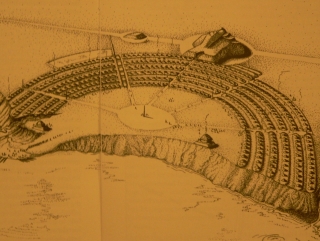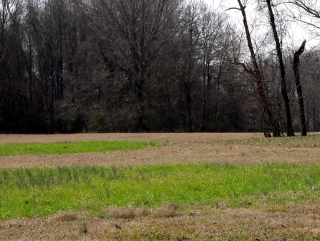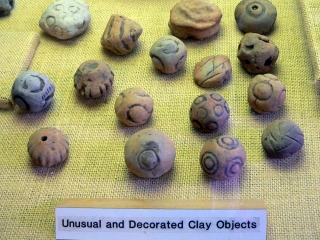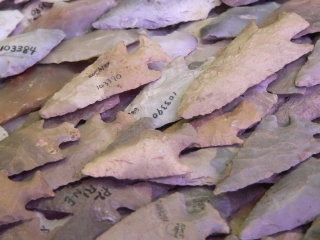NPS Website; Local Website; Video Website
WHAT IS IT?
 Gigantic and elaborate prehistoric earthworks whose construction began in 1700BC.
Gigantic and elaborate prehistoric earthworks whose construction began in 1700BC.Despite the name and inclusion of Poverty Point NM and SHS on the published list of National Park Sites there are no Federal facilities and it is not, by our account, actually a National Park Site. Confused? Us, too.
In the late 1980’s a Louisiana Congressman lobbied for Poverty Point to be a Park Site. Poverty Point was declared a National Monument in 1988; problem was that the Louisiana State Park Service had jurisdiction and did not want to give up the Site. So to date, it is a State Park, run by Louisiana with no federal help.
BEAUTY (6/10)
From the ground, Poverty Point is barely distinguishable from the rolling fields around it, until you look a little closer and realize the different shades of grass form a pattern of concentric crescents stretching back to a large hill, which is, upon further inspection, a mound built in the shape of a bird.
These six giant concentric crescents were once six-foot high artificial embankments until 19th century plowing leveled them out again. The ends of the outermost crescent are nearly ¾ of a mile apart. If the embankments had been extended to form a complete circle, this distance would roughly be the outermost circle’s diameter.
The eagle effigy, located in the center of outside half-circle’s edge is 70 feet high and measures 640 feet from wing to wing and 710 feet from head to tail. Its immensity is now hidden by woodland growth; it looks like an anonymous hill.
A bird’s eye view would show Poverty Point in all of its geometric perfection. Unfortunately, the Observation Tower is outdated and in need of repair. It was closed during our visit.
 HISTORICAL INTEREST (8/10)
HISTORICAL INTEREST (8/10)Poverty Point stakes a claim as the oldest known city in the United States. It is hard to argue with the evidence. Everything about the Site is astounding: the age, size and geometric exactitude. You are left with a profound sense of wonderment. Who were these people? The time coincides with Hammurabi’s Babylon, Tutankhamen’s Egypt, and the England of Stonehenge. The earthworks at Poverty Point show a civilization just as advanced. The excellent Museum is filled with artifacts unearthed at the site. Poverty Point is deservedly on the UNESCO shortlist for World Heritage Sites.
CROWDS (6/10)
We were alone. There were no crowds to affect us in any way.
EASE OF USE/ACCESS (2/5)
Poverty Point NM and SHS is a relatively short distance from Interstate 20, about 15 miles. Those 15 miles will take at least a half-hour to traverse. Take the Delhi Exit; travel north on Louisiana Route 17, then east on LA 134 and then north on LA 577. Signs are few and far between.
Do not approach the Site from U.S. Route 65 north of Tallulah. The Rand McNally shows a road, LA 580, that travels right to the Site. There may be a road, but for the 15 or so miles from U.S. 65 to Poverty Point, the road is one lane and extremely bumpy. It passes mostly duck hunting camps and is not made for delicate Nissan Altimas.
At the Site itself, a one-lane road weaves through the embankments and takes you to the base of the eagle effigy.
CONCESSIONS/BOOKSTORE (2/5)
Not much for sale, but the thick Poverty Point booklet you receive free with admission is more than enough.
COSTS (4/5)
$2 per adult. The Anthropological Study Series #7 booklet on Poverty Point and a 20-minute film comes with the price of admission.
 RANGER/GUIDE TO TOURIST RATIO (5/5)
RANGER/GUIDE TO TOURIST RATIO (5/5)The woman who greeted us explained why Poverty Point wasn’t really a National Monument and still convinced us to stay with her humor, knowledge, and that booklet! She sent us in to watch the film and two other volunteers were in her place when we emerged.
TOURS/CLASSES (8/10)
The introductory film and the Site Museum were both excellent, as is the 36-page Anthropological Study Series book. The video, which originally aired on Louisiana Public Television, utilizes snazzy 3-D computer graphics that make these earthwork wonders more understandable.
The highlight of the Museum is its extensive collective of artifacts unearthed at the monument. Fertility sculptures, decorated objects, molded clay balls used for cooking and hundreds of spear points. We had a constant sense of astonishment and admiration at the 3,000-year-old culture revealed at Poverty Point.
FUN (8/10)
We were a little disappointed when we arrived at Poverty Point and found out it was not a National Park Site. It had taken us about an hour and a half to get there from Vicksburg, Miss. where we were staying the night. This was going to be a long detour.
Our disappointment heightened when we saw no cars in the parking lot, a shut down observation tower, no apparent evidence of earthworks, a $2 a person entrance fee and no National Park Passport stamp. How long would we be here, do we even want to go into the Visitor Center?
Thank heavens we went in. The State Park Service Ranger quickly drew us into the incredible artifacts that had escaped our anger-clouded eyes. We soon understood that we were at one of the more amazing and mysterious places in North America. We had a great time letting our imagination go free because of the wonderful background information and hard evidence provided at the Visitor Center/Museum.
 WOULD WE RECOMMEND? (7/10)
WOULD WE RECOMMEND? (7/10)Poverty Point has been our favorite earthwork-related Native American Site partly because it is so much older than Ocmulgee and Hopewell Culture. The educational opportunities are stellar; this Site is an unknown world wonder. The Site’s main deterrent is its inaccessibility. Northeastern rural Louisiana is not an A-list tourist destination.
Another is the human destruction that the Site has undergone. If you expect to see the Pyramids of Giza at Poverty Point, you will be let down; farmers destroyed much of this old City as they leveled the land to plow. Had the ancient people of Poverty Point had stone to build their cities, this Site may have looked similar to the towering temples of Central and South America.
TOTAL 56/80
www.usa-c2c.com
© 2004-06